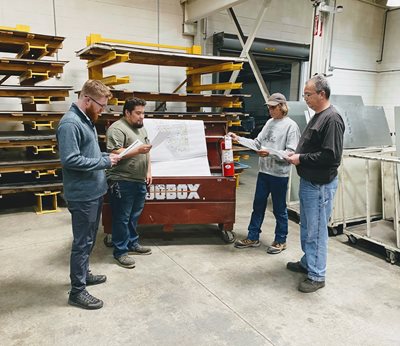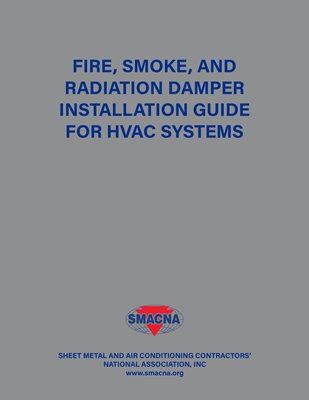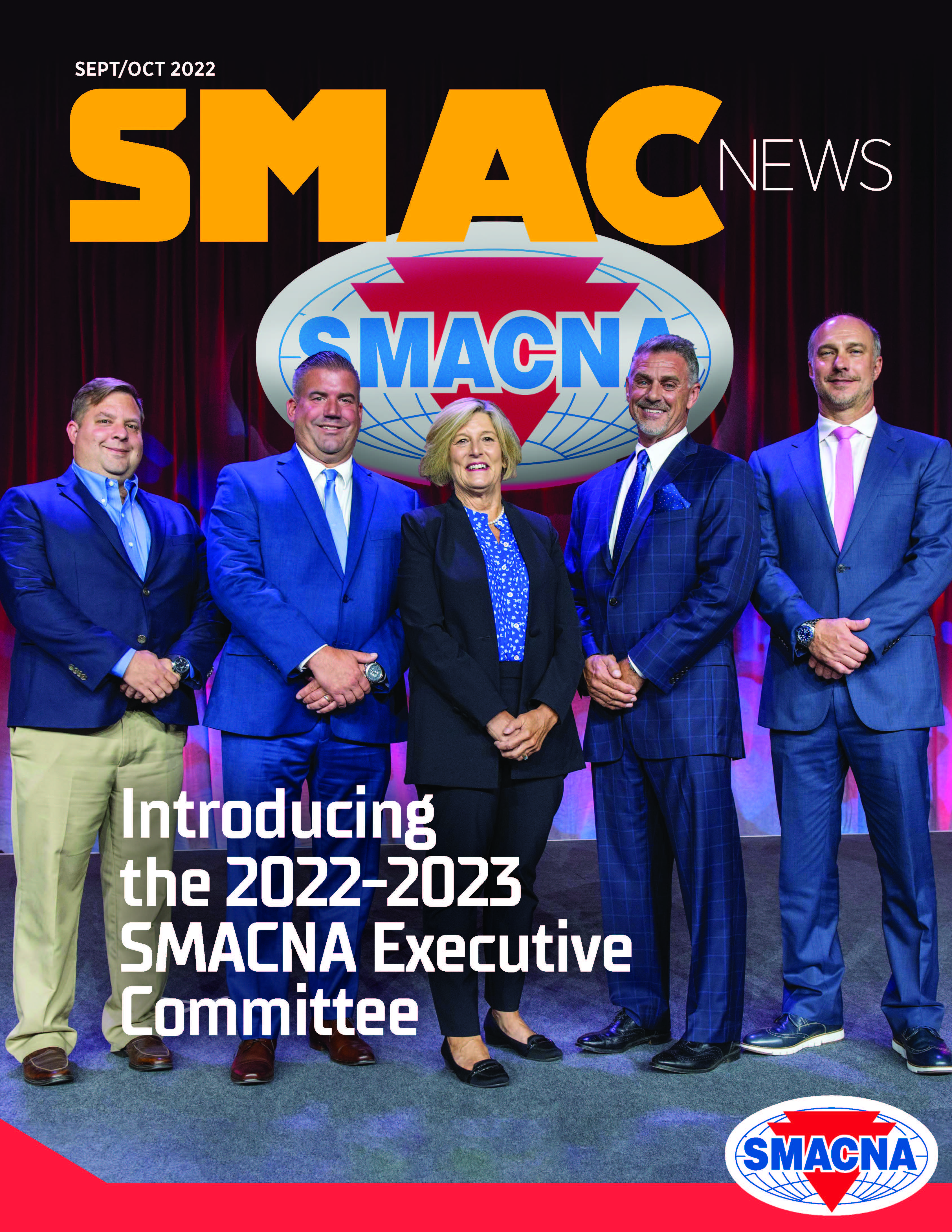Focusing on Fire Safety
SMACNA introduces Fire, Smoke, and Radiation Damper Installation Guide for HVAC Systems, 6th Edition.

A Duct Fabricators Inc. crew goes through Toolbox Talks training on jobsite safety topics, including fire safety. Photos: John Sickle Jr.
Fall is the perfect time for education on the latest fire safety standards. This year, it is also time to talk about SMACNA’s well-timed release of its Fire, Smoke, and Radiation Damper Installation Guide for HVAC Systems, 6th Edition.
The 6th edition guide is updated from its 2002 version with some new resources and insight for contractors.
“Fire dampers are at the forefront of what we do every day,” said Nathan Dills, president of the Oklahoma-based ACP Sheet Metal Company, past president of SMACNA, and chairman of the SMACNA task force in charge of creating the updated Fire, Smoke, and Radiation Damper Installation Guide for HVAC Systems. “When we estimate jobs and notice a fire damper isn’t going into a hallway where it is supposed to be, or are commonly used to seeing it there … or if we notice there’s no fire sprinkler plan, we have to ask questions and find out why.”
John E. Sickle Jr., president of Duct Fabricators Inc. in Cleveland, Ohio and Ohio Fabricators Inc. in Akron, added that fire prevention and safety are critical in HVAC work. After all, if fire and smoke enter the system, it becomes a major path for its spread. Sickle is passionate about fire safety and keeps a strong focus on it at his company all year long.
The new guide offers some updates that give contractors the tools they need to succeed in this area of the business.
Why is Fire Safety and Learning About Fire Damper Installation and InspectionS So Important?
First and foremost, Sickle urges everyone to become versed in the model codes, which includes those of the National Fire Protection Association (NFPA). Learning the codes provides incredibly valuable knowledge and material to use for employee and customer education. The NFPA also regularly updates their standards as the industry and codes evolve.

SMACNA's updated Fire, Smoke, and Radiation Damper Installation Guide for HVAC Systems
“We make sure that all of our employees are well-versed on the latest NFPA standards and that they have a strong knowledge of the installation methods for Fire Life Safety Devices within the HVAC system,” says Sickle. “A good majority of this knowledge is conducted through our local JATC’s as well as our own in-house seminars.”
In addition to having fire extinguishers in every gang box, Sickle’s crews go through weekly Toolbox Talks pertaining to all jobsite safety topics — fire safety being a critical and frequent topic of discussion.
Knowing how to do this work properly is also important, which is what SMACNA’s new guide brings to the table.
New Guide Addition #1: Fire Damper Installation Responsibility
First, the new guide gives contractors the tools to determine where the responsibility for fire damper installation lies.
And this is extremely important, Dills said, because fire damper installation is not the contractor’s job. “This responsibility actually falls on the engineers or design professionals,” he explained. “We need to alert the design professional or engineer if we notice a fire damper is required by code on a property, but it’s not in the plan. But it’s not our job to install what is not shown on the plans.”
As an informational service to design professionals, the new guide also includes an appendix in the back explaining the proper location for fire dampers. Contractors can use the appendix for their educational purposes and to work better with design professionals.
New Guide Addition #2: Fire Damper Inspection Guide
Two of Sickle’s companies are family-owned businesses, started by his father. Both are large commercial/industrial HVAC contractors with a nucleus of the business surrounding sheet metal ductwork. According to Sickle, the Cleveland office conducts a good majority of HVAC work with governmental contractors, including the NASA facility in Cleveland and the Cleveland VA Medical Center. The Akron firm conducts a good majority of work in the hospital arena.
Both companies have a large presence in the Fire Life Safety Damper inspection and repair market in Northeast Ohio.
Sickle says that in recent years, clients have also become increasingly aware of fire safety — and of the importance of maintaining and monitoring Fire Life Safety devices on a regular basis. In fact, Duct Fabricators has an ongoing contract with the County of Cuyahoga/Cleveland that includes inspecting and repairing all Fire Life Safety Damper devices in their buildings and facilities.
“The county is well versed on the requirements and standards for Fire Life Safety within the HVAC system,” Sickle says. “Duct Fabricators works closely with the county to maintain their devices. Continuously maintaining and monitoring Fire Life Safety devices on a regular basis is a huge step in the proper direction of assisting in the battle of fire prevention. We also have a similar ongoing contract with the VA Hospital in Cleveland.”
More contractors are offering fire damper inspections as a service, Dills said, which made adding an inspection section to the Fire, Smoke, and Radiation Damper Installation Guide for HVAC Systems essential. The new section gives contractors insight on how often they should inspect and test fire dampers. Depending on the type of commercial-institutional property, this can be every 4 or 6 years, per NFPA.
“This section talks about how to properly conduct a fire damper inspection, which is important because a lot of places like hospitals need these services,” Dills said. “Health inspectors are asking for fire damper inspection reports, and contractors are able to offer this service and help them ensure their fire dampers are working properly.”
Inspections can potentially save commercial property managers and building owners from liability issues in case a fire should occur, making these reports essential for them to have as necessary.
To get a copy of SMACNA’s Fire, Smoke, and Radiation Damper Installation Guide for HVAC Systems, 6th Edition, visit SMACNA’s Bookstore at www.SMACNA.org.
Published: October 31, 2022
IN THIS ISSUE
Big Project Requires Big Ductwork
Apollo Mechanical tackles a project for one of the world’s largest manufacturers in the semiconductor industry.
Building Based on Relationships
This Canadian sheet metal company is thriving without a shop, building a successful business on the back of great relationships.
Capitol Hill Update: FY2023 Budget: Chaos Again With No Final Budget
The House has passed one government funding package consisting of six spending bills for the fiscal year that begins on Oct. 1. But the remaining six measures — including the two biggest bills, Defense and Labor-HHS-Education — won’t see any floor
CEO UPDATE: SMACNA Focuses On 2023 Priorities
It was wonderful to see so many SMACNA members at our convention in Colorado Springs. The Broadmoor is one of my favorite destinations, and it did not disappoint. I have always admired their ability to provide outstanding customer service every time
Expanded Section 179D Tax Savings for Energy-Efficient Building & Design
The Inflation Reduction Act, signed and passed into law on August 16, 2022, includes $369 billion in climate and energy spending.
Finding and Keeping Good Field Leaders
Field supervisors, project managers and superintendents represent an outsized slice of the struggle to attract and retain talented people. There are two major challenges to finding and keeping good field leaders.
Focusing on Fire Safety
SMACNA introduces Fire, Smoke, and Radiation Damper Installation Guide for HVAC Systems, 6th Edition.
In-House, Local Fabrication Helps Secure Building Project
IMC’s location, unique skillset and general contractor relationship secures them a 5-story, mixed-use building project in Sioux City, Iowa.
NLRB’s Recent Activity Constrains Employer Dress-Code Rights, Increases Joint-Employment Exposure
A flurry of late-summer activity from the Biden-dominated NLRB has produced at least two noteworthy changes for employers regarding displays of union insignia, and joint-employer status.
SMACNA Convention: Building Resilience Through Adaptation
Amid constant change, SMACNA convention attendees learn to adapt and grow.
Spotlight On Indoor Air Quality
It is a great privilege to serve as SMACNA’s president and to have seen so many of you at SMACNA’s National Convention in Colorado Springs. As I mentioned on stage, one of my favorite sayings to live by is, “If it's worth doing, it’s worth doing
Welcome New SMACNA Members
Welcome New SMACNA Members
What All Contractors Need To Know About CMMC
Honestly, this is the freight train that is heading toward the construction industry, and while some contractors are aware and working on this, so many companies in construction have no real clue about this potentially harmful (financially)


